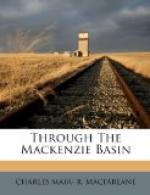Shortly after our arrival at the Landing, news, true or false, reached us that the ice was still fast on Lesser Slave Lake. At any rate, the boat’s crew expected from there did not turn up, and a couple of days were spent in anxious waiting. Some freight was delayed as well, and a thunderstorm and a night of rain set the camp in a swim. The non-arrival of our trackers was serious, as we had two scows and a York boat, with a party all told of some fifty souls, and only thirteen available trackers to start with. It seemed more than doubtful whether we could reach Lesser Slave Lake on treaty-schedule time, and the anxiety to push on was great. It was decided to set out as we were and trust to the chapter of accidents. We did not foresee the trials before us, the struggle up a great and swift river, with contrary winds, rainy weather, weak tracking lines and a weaker crew. The chapter of accidents opened, but not in the expected manner.
The York boat and one of the scows were fitted up amidships with an awning, which could be run down on all sides when required, but were otherwise open to the weather, and much encumbered with lading; but all things being in readiness, on the 3rd of June we took to the water, and, a photograph of the scene having been taken, shoved off from the Landing. The boats were furnished with long, cumbrous sweeps, yet not a whit too heavy, since numbers of them snapped with the vigorous strokes of the rowers during the trip. A small sweep, passed through a ring at the stern, served as a rudder, by far the best steering gear for the “sturgeons,” but not for a York boat, which is built with a keel and can sail pretty close to the wind. Ordinarily the only sail in use is a lug, which has a great spread, and moves a boat quickly in a fair wind. In a calm, of course, sweeps have to be used, and our first step




